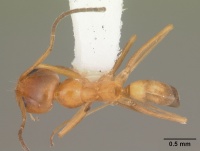Dorymyrmex bureni
| Dorymyrmex bureni | |
|---|---|

| |
| Scientific classification | |
| Kingdom: | Animalia |
| Phylum: | Arthropoda |
| Class: | Insecta |
| Order: | Hymenoptera |
| Family: | Formicidae |
| Subfamily: | Dolichoderinae |
| Tribe: | Leptomyrmecini |
| Genus: | Dorymyrmex |
| Species: | D. bureni |
| Binomial name | |
| Dorymyrmex bureni (Trager, 1988) | |
In the southeastern U.S., this ant is common in open, disturbed areas with sandy soils.
Identification
Trager (1988) - The common yellow Dorymyrmex of disturbed soils (especially in sandy areas) in the Southeast; convexity of pronotum forms a continuous curvature with mesonotal dorsum in profile; propodeal cone generally lower and blunter than that of Dorymyrmex flavopectus.
Dorymyrmex bureni is structurally very close to D. flavopectus. It seems certain, in view of the biologies of the 2 species, that much of the literature referring to D. flavopecta in fact concerns D. bureni, following the lead of Creighton (1950) who, apparently incognizant of the ecology of Smith's species, played down the difference in color pattern of the 2 species and expanded the taxon to include any Dorymyrmex with the appropriate thoracic structure. The shorter scapes and monocalic colonies of D. bureni are the good features for distinguishing D. bureni from D. flavopectus, and the striking contrast of the clear yellow trunk and dark brown head and gaster of D. flavopectus is not seen in D. bureni.
Dorymyrmex flavus was recently reported as species distinct from Dorymyrmex insanus (Cokendolpher & Francke 1984), with which it had been synonymized by Snelling (1973). It is a Texas and southern plains-state species very similar to D. bureni in gross worker morphology and in its ecology. The angularity of the mesonotum of this similarly yellowish western species is variable, but in most workers of any nest series, the mesonotum has distinct dorsal and declivous faces. The few males of D. flavus I have seen have the small ocelli characteristic of day-flying species, which may consistently distinguish them from males of the night-flying D. bureni, when males of both are better collected.
Keys including this Species
- Key to Dorymyrmex of SE United States queens
- Key to Dorymyrmex of SE United States workers
- Key to Nearctic Dorymyrmex
Distribution
Snelling (1995) - Trager (1988) gives the range of D. bureni as extending from Maryland and Virginia south to Florida and west to Mississippi. I have seen samples from several localities in Louisiana and workers collected at Columbus, Colorado County, Texas.
Latitudinal Distribution Pattern
Latitudinal Range: 39.53743° to 16.6583°.
| North Temperate |
North Subtropical |
Tropical | South Subtropical |
South Temperate |
- Source: AntMaps
Distribution based on Regional Taxon Lists
Nearctic Region: United States (type locality).
Neotropical Region: Mexico.
Distribution based on AntMaps
Distribution based on AntWeb specimens
Check data from AntWeb
Countries Occupied
| Number of countries occupied by this species based on AntWiki Regional Taxon Lists. In general, fewer countries occupied indicates a narrower range, while more countries indicates a more widespread species. |

|
Biology
Trager (1988) - Dorymyrmex bureni is the characteristic yellow Dorymyrmex of roadsides, planted and fallow fields, pastures, lawns and parks throughout Florida and the Southeast, especially in areas with sandy soils. It occurs naturally in coastal dunes, and near seasonal ponds among Andropogon and other clumping grasses in "fossil" dunes. This species may be favored by appropriate cultural practices in crop systems to provide biological pest control. It is an avid predator of small arthropods in citrus and soybeans [Whitcomb et al. 1972, Elvin et al. 1983 (Dorymyrmex sp.), Tryon 1986 (Dorymyrmex edeni, nomen nudum)] is non-noxious to humans and their crop plants, and is quick to colonize newly-tilled ground. Foraging occurs in all but the hottest portion of the day in the warmer seasons and even on warm, sunny days in winter. Workers from incipient colonies are reported to be mostly nocturnal (Buren et al. 1975). Colonies normally inhabit only one nest at a time, but during the fall and spring, when nest emigrations are frequent, a colony may temporarily inhabit 2 or 3 nests.
Mating flights occur on warm nights after or even during rain from spring through fall. Peak flight activity occurs at dusk, but I have observed copulating specimens flying in low numbers to a blacklight throughout the night and even at dawn.
This species is known to remove seeds (Atchison & Lucky, 2022; Cumberland & Kirkman, 2012; Stuble et al., 2010).
Association with Other Organisms
 Explore: Show all Associate data or Search these data. See also a list of all data tables or learn how data is managed.
Explore: Show all Associate data or Search these data. See also a list of all data tables or learn how data is managed.
- This species is a host for the ant Dorymyrmex reginicula (a inquiline).
- This species is a prey for the tiger beetle Ellipsoptera hirtilabris (a predator) in United States (MacRae, 2019; Polidori et al., 2020) (ant species uncertain, either Dorymyrmex bureni or Dorymyrmex flavus).
Flight Period
| X | X | X | X | X | |||||||
| Jan | Feb | Mar | Apr | May | Jun | Jul | Aug | Sep | Oct | Nov | Dec |
Source: antkeeping.info.
- Check details at Worldwide Ant Nuptial Flights Data, AntNupTracker and AntKeeping.
- Explore: Show all Flight Month data or Search these data. See also a list of all data tables or learn how data is managed.
Castes
Queen
Images from AntWeb
 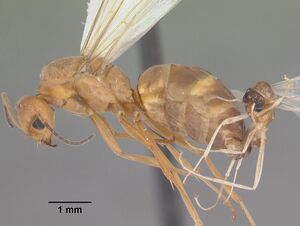  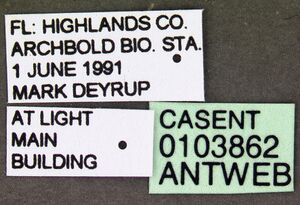 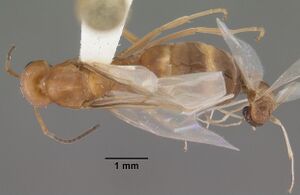
| |
| Queen (alate/dealate). Specimen code casent0103862. Photographer April Nobile, uploaded by California Academy of Sciences. | Owned by ABS, Lake Placid, FL, USA. |
Male
Images from AntWeb
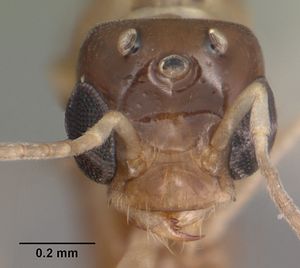    
| |
| Male (alate). Specimen code casent0102701. Photographer April Nobile, uploaded by California Academy of Sciences. | Owned by ABS, Lake Placid, FL, USA. |
Nomenclature
The following information is derived from Barry Bolton's Online Catalogue of the Ants of the World.
- bureni. Conomyrma bureni Trager, 1988: 19, figs. 2, 9, 19, 20 (w.q.) U.S.A. Combination in Dorymyrmex: Snelling, R.R. 1995: 7. Material of the nomen nudum edeni referable here: Trager, 1988: 19. Junior synonym of flavus: Johnson, C. 1989b: 187. Revived from synonymy: Snelling, R.R. 1995: 7.
Unless otherwise noted the text for the remainder of this section is reported from the publication that includes the original description.
Description
Worker
HL 0.85-1.05 (0.98), HW 0.71-1.00 (0.88), SL 0.90-1.10 (1.03), EL 0.23-0.28 (0.25), FL 0.80-1.00 (0.90), Wi, 1.08-1.40 (1.25), HTL 1.93-2.45 (2.23), C1 83.5-95.2 (89.8), S1 110.0-126.8 (117.0), or 23.8-28.6 (25.5), F1 89.8-100.0 (91.8), TI 126.7-150.6 (127.6). N =25.
General form and characters as in figures, and in key. Head widest above eyes, sides evenly convex or sometimes converging a little more strongly toward mandibular bases; occipital border weakly concave in larger workers to weakly convex in smaller ones; promesonotal curvature usually as in figure, though less arched in some small workers and many specimens from the northwestern part of the species' range. C. bureni only rarely shows even a trace of distinct basal and declivous faces in mesonotal profile.
Mandibles striate from base nearly to teeth near inner border; striae becoming increasingly obsolete distally along outer border, yielding a shining subtriangular space subtending 3 or 4 most apical teeth; fine tessellation and short, dense, whitish pubescence yield a feebly shining front and dorsum of head, and thorax; sculpture weaker and pubescence less dense on sides of head and gula, rear face of propodeum, and petiole, but stronger and denser on gaster, the former parts correspondingly shinier, gaster duller.
Color ranging from clear orange-yellow with head slightly darker and posterior part of gaster brownish, to entire body mousy brown with thorax and base of gaster a little lighter and yellower; great majority of specimens lie near the lighter end of the spectrum with part of head and posterior 112 of gaster lightly infuscate; most darker specimens observed came from coastal areas of Georgia and northeastern Florida, while the yellowest specimens came from south-central Florida.
Queen
HL 1.19-1.25, HW 1.18-1.28, SL 1.08-1.15, EL 0.40-0.43, TW 1.18-1.38, WL 2.38-2.45, HTL 3.58-3.70, C1 99.2-106.7, S1 84.4-93.2, or 32.0-34.4, TW1 93.8-107.8, T1 194.4-204.2. N = 10.
Head usually a little broader than long, occasionally slightly longer; sides of head weakly angular, convex and subparallel above midlength of eyes, straighter and convergent below; eyes notably convex, their outer margin lying close to or even protruding beyond sides of head; occipital border about as broad as clypeus, weakly convex; thorax about equal to head in width.
Sculpture as in worker; pubescence longer, thus queen a little less shiny; color of head, thorax and base of gaster usually a little darker and more reddish than in worker; remainder of gaster brown, fading to reddish near edges of tergites.
Type Material
Holotype and 32 paratypes: FLORIDA, Alachua Co.: Gainesville. Emerging for mating flight from nest in lawn. 15 June 1987. James C. Trager leg. Holotype, Florida State Collection of Arthropods . Paratypes James C. Trager Collection, Florida State Collection of Arthropods , Archbold Biological Station, Los Angeles County Museum of Natural History, National Museum of Natural History, Museum of Comparative Zoology, American Museum of Natural History.
Etymology
C. bureni is named after the late William F. Buren, who first recognized it as a species distinct from C. flavopectus and C. flava.
References
- Alatorre-Bracamontes, C.E., Vásquez-Bolaños, M. 2010. Lista comentada de las hormigas (Hymenoptera: Formicidae) del norte de México. Dugesiana 17(1): 9-36.
- Atchison, R. A., Lucky, A. 2022. Diversity and resilience of seed-removing ant species in Longleaf Sandhill to frequent fire. Diversity 14, 1012 (doi:10.3390/d14121012).
- Cumberland, M.S., Kirkman, L.K. 2012. The effects of disturbance on the red imported fire ant (Solenopsis invicta) and the native ant community. Forest Ecology and Management 279, 27–33.
- Davis, T. 2009. The ants of South Carolina (thesis, Clemson University).
- Deyrup, M.A., Carlin, N., Trager, J., Umphrey, G. 1988. A review of the ants of the Florida Keys. Florida Entomologist 71: 163-176.
- Gochnour, B.M., Suiter, D.R., Booher, D. 2019. Ant (Hymenoptera: Formicidae) fauna of the Marine Port of Savannah, Garden City, Georgia (USA). Journal of Entomological Science 54, 417-429 (doi:10.18474/jes18-132).
- Hill, J.G. 2015. Ants (Hymenoptera: Formicidae) of the Big Thicket Region of Texas. Midsouth Entomologist 8: 24-34.
- Ipser, R.M., Brinkman, M.A., Gardner, W.A., Peeler, H.B. 2004. A survey of ground-dwelling ants (Hymenoptera: Formicidae) in Georgia. Florida Entomologist 87: 253-260.
- Johnson, C. 1989b. Taxonomy and diagnosis of Conomyrma insana (Buckley) and C. flava (McCook) (Hymenoptera: Formicidae). Insecta Mundi 3: 179-194 (page 187, Junior synonym of flavus)
- MacGown, J.A., Booher, D., Richter, H., Wetterer, J.K., Hill, J.G. 2021. An updated list of ants of Alabama (Hymenoptera: Formicidae) with new state records. Transactions of the American Entomological Society 147: 961-981 (doi:10.3157/061.147.0409).
- Moura, M.N., Cardoso, D.C., Cristiano, M.P. 2020. The tight genome size of ants: diversity and evolution under ancestral state reconstruction and base composition. Zoological Journal of the Linnean Society, zlaa135 (doi:10.1093/zoolinnean/zlaa135).
- Oberski, J.T. 2022. First phylogenomic assessment of the amphitropical New World ant genus Dorymyrmex (Hymenoptera: Formicidae), a longstanding taxonomic puzzle. Insect Systematics and Diversity 6(1): 8; 1–10 (doi:10.1093/isd/ixab022).
- Polidori, C., Rodriguez-Flores, P.C., Garcia-Paris, M. 2020. Ants as prey for the endemic and endangered Spanish tiger beetle Cephalota dulcinea (Coleoptera: Carabidae). Annales de la Société entomologique de France (N.S.) (doi:10.1080/00379271.2020.1791252).
- Snelling, R. R. 1995a. Systematics of Nearctic ants of the genus Dorymyrmex (Hymenoptera: Formicidae). Contr. Sci. (Los Angel.) 454: 1-14 (page 7, Combination in Dorymyrmex, Revived from synonymy)
- Stuble, K.L., Kirkman, L.K., Carroll, C.R. 2010. Are red imported fire ants facilitators of native seed dispersal? Biological Invasions 12, 1661–1669.
- Trager, J.C. 1988. A revision of Conomyrma (Hymenoptera: Formicidae) from the southeastern United States, especially Florida, with keys to the species. Florida Entomologist 71: 11-29. (page 19, figs. 2, 9, 19, 20 worker, queen described; Material of the nomen nudum edeni referable here)
- Tschinkel, W.R. 2015. The architecture of subterranean ant nests: beauty and mystery underfoot. Journal of Bioeconomics 17:271–291 (DOI 10.1007/s10818-015-9203-6).
References based on Global Ant Biodiversity Informatics
- Addison D. S., I. Bartoszek, V. Booher, M. A. Deyrup, M. Schuman, J. Schmid, and K. Worley. 2016. Baseline surveys for ants (Hymenoptera: Formicidae) of the western Everglades, Collier County, Florida. Florida Entomologist 99(3): 389-394.
- Alatorre-Bracamontes, C.E. and M Vasquez-Bolanos. 2010. Lista comentada de las hormigas (Hymenoptera: Formicidae) del norte de México. Dugesiana 17(1):9-36
- Annotated Ant Species List Ordway-Swisher Biological Station. Downloaded at http://ordway-swisher.ufl.edu/species/os-hymenoptera.htm on 5th Oct 2010.
- Bowers D. Q. 2018. An investigation of the distribution and behavior of the Dark Rover Ant, Brachymyrmex patagonicus Mayr, in South Carolina. Clemson University Master's Thesis 99pp.
- Braman C. A., and B. T. Forschler. 2018. Survey of Formicidae attracted to protein baits on Georgia’s Barrier Island dunes. Southeastern Naturalist 17(4): 645-653.
- Dash S. T. and L. M. Hooper-Bui. 2008. Species diversity of ants (Hymenoptera: Formicidae) in Louisiana. Conservation Biology and Biodiversity. 101: 1056-1066
- Dattilo W. et al. 2019. MEXICO ANTS: incidence and abundance along the Nearctic-Neotropical interface. Ecology https://doi.org/10.1002/ecy.2944
- Deyrup M., L. Deyrup, and J. Carrel. 2013. Ant Species in the Diet of a Florida Population of Eastern Narrow-Mouthed Toads, Gastrophryne carolinensis. Southeastern Naturalist 12(2): 367-378.
- Epperson, D.M. and C.R. Allen. 2010. Red Imported Fire Ant Impacts on Upland Arthropods in Southern Mississippi. American Midland Naturalist, 163(1):54-63.
- Forster J.A. 2005. The Ants (hymenoptera: Formicidae) of Alabama. Master of Science, Auburn University. 242 pages.
- Frye J. A., T. Frye, and T. W. Suman. 2014. The ant fauna of inland sand dune communities in Worcester County, Maryland. Northeastern Naturalist, 21(3): 446-471.
- General D.M. & Thompson L.C. 2007. Ants (Hymenoptera: Formicidae) of Arkansas Post National Memorial. Journal of the Arkansas Acaedemy of Science. 61: 59-64
- General D.M. & Thompson L.C. 2008. New Distributional Records of Ants in Arkansas for 2008. Journal of the Arkansas Academy of Science. 63: 182-184
- Graham J.H., H.H. Hughie, S. Jones, K. Wrinn, A.J. Krzysik, J.J. Duda, D.C. Freeman, J.M. Emlen, J.C. Zak, D.A. Kovacic, C. Chamberlin-Graham, H. Balbach. 2004. Habitat disturbance and the diversity and abundance of ants (Formicidae) in the Southeastern Fall-Line Sandhills. 15pp. Journal of Insect Science. 4: 30
- Graham, J.H., A.J. Krzysik, D.A. Kovacic, J.J. Duda, D.C. Freeman, J.M. Emlen, J.C. Zak, W.R. Long, M.P. Wallace, C. Chamberlin-Graham, J.P. Nutter and H.E. Balbach. 2008. Ant Community Composition across a Gradient of Disturbed Military Landscapes at Fort Benning, Georgia. Southeastern Naturalist 7(3):429-448
- Guzman-Mendoza R., G. Castano-Meneses, and M. de Carmen Hererra-Fuentes. 2010. Spatial and temporal variation of the diversity ants in the Botanic Garden from Zapotitlán de las Salinas Valley, Puebla. Revista Mexicana de Biodiversidad 81: 427- 435.
- Ipser R. M. 2004. Native and exotic ants (Hymenoptera: Formicidae) of Georgia: Ecological Relationships with implications for development of biologically-based management strategies. Doctor of Philosophy thesis, University of Georgia. 165 pages.
- Ipser, R.M., M.A. Brinkman, W.A. Gardner and H.B. Peeler. 2004. A Survey of Ground-Dwelling Ants (Hymenoptera: Formicidae) in Georgia. The Florida Entomologist 87(3) 253-260.
- Ivanov K., L. Hightower, S. T. Dash, and J. B. Keiper. 2019. 150 years in the making: first comprehensive list of the ants (Hymenoptera: Formicidae) of Virginia, USA. Zootaxa 4554 (2): 532–560.
- Johnson R. Personnal Database. Accessed on February 5th 2014 at http://www.asu.edu/clas/sirgtools/resources.htm
- Klotz, J.H., J.R. Mangold, K.M. Vail, L.R. Davis Jr., R.S. Patterson. 1995. A survey of the urban pest ants (Hymenoptera: Formicidae) of Peninsular Florida. Florida Entomologist 78(1):109-118
- Longino, J.T. 2010. Personal Communication. Longino Collection Database
- Lubertazzi D. and Tschinkel WR. 2003. Ant community change across a ground vegetation gradient in north Floridas longleaf pine flatwoods. 17pp. Journal of Insect Science. 3:21
- MacGown J. A. 2015. Report on the ants collected on Spring Island, Beaufort County, South Carolina. A report submitted to Spring Island Nature Preserve, May 2015. Mississippi Entomological Museum Report #2015-01. 8 pp
- MacGown J. A., J. G. Hill, L. C. Majure, and J. L. Seltzer. 2008. Rediscovery of Pogonomyrmex badius(Latreille) (Hymenoptera: Formicidae) in Mainland Mississippi, with an Analysis of Associated Seeds and Vegetation. Midsouth Entomologist 1: 17-28.
- MacGown J. A., J. G. Hill, R. L. Brown, T. L. Schiefer, J. G. Lewis. 2012. Ant diversity at Noxubee National Wildlife Refuge in Oktibbeha, Noxubee, and Winston Counties, Mississippi. Mississippi Agricultural and Forestry Experiment Station Bulletin 1197: 1-30
- MacGown J. A., J. G. Hill, and M. Deyrup. 2009. Ants (Hymenoptera: Formicidae) of the Little Ohoopee River Dunes, Emanuel County, Georgia. J. Entomol. Sci. 44(3): 193-197.
- MacGown J. A., J. G. Hill, and R. L. Brown. 2010. Native and exotic ant in Mississippi state parks. Proceedings: Imported Fire Ant Conference, Charleston, South Carolina, March 24-26, 2008: 74-80.
- MacGown J. A., and R. Whitehouse. 2015. A preliminary report of the ants of West Ship Island. A report submitted to the Gulf Islands National Seashore. Mississippi Entomological Museum Report #2015-02. 9 pp.
- MacGown, J. A. and J. G. Hill. 2010. Two new exotic pest ants, Pseudomyrmex gracilis and Monomorium floricola (Hymenoptera: Formicidae) collected in Mississippi. Midsouth Entomologist 3 (2): 106-109.
- MacGown, J. and J.G. Hill. Ants collected at Palestinean Gardens, George County Mississippi.
- MacGown, J.A and J.A. Forster. 2005. A preliminary list of the ants (Hymenoptera: Formicidae) of Alabama, U.S.A. Entomological News 116(2):61-74
- MacGown, J.A. and JV.G. Hill. Ants of the Great Smoky Mountains National Park (Tennessee and North Carolina).
- MacGown, J.A. and T. Lockley. Ants of Horn Island, Jackson County, Mississippi
- MacGown, J.A., J.G. Hill, R.L. Brown and T.L. 2009. Ant Diversity at Noxubee National Wildlife Refuge in Oktibbeha, Noxubee, and Winston Counties, Mississippi Report #2009-01. Schiefer. 2009.
- Michigan State University, The Albert J. Cook Arthropod Research Collection. Accessed on January 7th 2014 at http://www.arc.ent.msu.edu:8080/collection/index.jsp
- Moreau C. S., M. A. Deyrup, and L. R. David Jr. 2014. Ants of the Florida Keys: Species Accounts, Biogeography, and Conservation (Hymenoptera: Formicidae). J. Insect Sci. 14(295): DOI: 10.1093/jisesa/ieu157
- Snelling R.R. 1995. Systematics of Nearctic Ants of the Genus Dorymyrmex (Hymenoptera: Formicidae). Contributions in Science. 454: 1-14
- Snelling, R.R. 1995. Sytematics of Nearctic ants of the genus Dorymyrmex (Hymenoptera: Formicidae). Contributions in Science Natural Histrory Museum of Los Angeles County 454:1-14
- Trager J. C. 1988. A revision of Conomyrma (Hymenoptera: Formicidae) from the southeastern United States, especially Florida, with keys to the species. Florida Entomologist 71: 11-29
- Vasquez-Bolanos M. 2011. Checklist of the ants (Hymenoptera: Formicidae) from Mexico. Dugesiana 18(1): 95-133.
- Vásquez-Bolaños M. 2011. Lista de especies de hormigas (Hymenoptera: Formicidae) para México. Dugesiana 18: 95-133
- Wetterer, J.K. and J.A. Moore. 2005. Red Imported Fire Ants (Hymenoptera: Formicidae) at Gopher Tortoise (Testudines: Testudinidae) Burrows. The Florida Entomologist 88(4):349-354
- Wiescher P. T., J. M. Pearce-Duvet and D. H. Feener. 2012. Assembling an ant community: species functional traits reflect environmental filtering. Oecologia 169: 1063-1074
- Pages using DynamicPageList3 parser function
- North temperate
- North subtropical
- Tropical
- Ant Associate
- Host of Dorymyrmex reginicula
- Tiger beetle Associate
- Host of Ellipsoptera hirtilabris
- FlightMonth
- Species
- Extant species
- Formicidae
- Dolichoderinae
- Leptomyrmecini
- Dorymyrmex
- Dorymyrmex bureni
- Dolichoderinae species
- Leptomyrmecini species
- Dorymyrmex species
- Ssr

